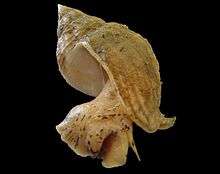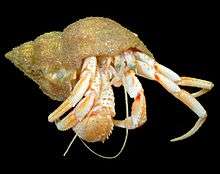Calliactis parasitica
Calliactis parasitica is a species of sea anemone associated with hermit crabs. It lives in the eastern Atlantic Ocean and Mediterranean Sea at depths between the intertidal zone and 60 m (200 ft). It is up to 10 cm × 8 cm (3.9 in × 3.1 in) in size, with up to 700 tentacles, and is very variable in colour. The relationship between C. parasitica and the hermit crab is mutualistic: the sea anemone protects the hermit crab with its stings, and benefits from the food thrown up by the hermit crab's movements.
| Calliactis parasitica | |
|---|---|
| Calliactis parasitica with the hermit crab Dardanus calidus | |
| Scientific classification | |
| Kingdom: | Animalia |
| Phylum: | Cnidaria |
| Class: | Anthozoa |
| Order: | Actiniaria |
| Family: | Hormathiidae |
| Genus: | Calliactis |
| Species: | C. parasitica |
| Binomial name | |
| Calliactis parasitica (Couch, 1844) | |
| Synonyms [1] | |
|
List
| |
Description
Calliactis parasitica is up to 100 millimetres (3.9 in) tall, and 80 mm (3.1 in) wide,[2][3] with the base of the column being slightly wider.[1] The surface of the column is rough and leathery with a grainy appearance, but has no tubercles and is not divided into sections.[1] It is variable in colouring,[1] but is usually cream or buff in colour, with blotches and streaks of reddish or greyish brown, which tend to form vertical stripes.[2]
The basal disc is concave, and able to stick firmly to the substrate.[1] Above this lies the limbus (the junction between the basal disc and the column), and just above that are the relatively prominent cinclides (specialised pores), each on a small mound.[1] These readily emit threadlike acontia (stings) when the animal is disturbed.[3] At the top of the column are up to 700 slender tentacles of moderate length.[2] They are translucent, and yellowish to orange in colour, with longitudinal lines of reddish brown.[3]
Distribution
Calliactis parasitica is found in the north-eastern Atlantic Ocean and the Mediterranean Sea.[2] Its Atlantic range extends from south-western Europe[2] as far north as the west coasts of Wales and Ireland,[3] and the English Channel.[1] Although this species has been recorded from the southern North Sea, those records are considered dubious.[1] The depth distribution of C. parasitica ranges from a depth of 60 metres (200 ft) to the sublittoral zone; it is rarely found in the littoral zone.[3]
Ecology

Although Calliactis parasitica will occasionally attach to stones or empty shells, it is typically found on a gastropod shell inhabited by a hermit crab, and several individuals may live on the same shell.[3] In the British Isles, the hermit crab is usually Pagurus bernhardus,[2] but other species may be associated with C. parasitica in other parts of its range.[1] C. parasitica is thought to use a chemical signal to detect its favoured shell, that of the whelk Buccinum undatum, because it has been observed in aquaria to mount the shell of a living B. undatum, although the whelk ensures that the sea anemone does not remain there.[3]

Calliactis parasitica can survive without the hermit crab, and the hermit crab can survive without C. parasitica, but they associate with each other to their mutual benefit; this is known as mutualism. The hermit crab gains protection from predators by the sea anemone's stinging, and the sea anemone gains an increase in food from the material thrown up by the hermit crab's movements.[3] The relationship is apparently instigated by the sea anemone, which begins a complex series of manoeuvres in order to mount the shell carried by the hermit crab; the hermit crab remains passive while these manoeuvres take place.[3]
Octopuses will avoid shells bearing C. parasitica, but will persist in attacking shells containing the hermit crab Pagurus prideaux and bearing the sea anemone Adamsia palliata.[4] In aquarium settings, the mutualism between C. parasitica and the hermit crab Dardanus arrosor can break down; this breakdown is prevented or reversed when chemical signals from octopuses are present. The presence of cephalopods may therefore be necessary for the relationship between the hermit crab and the anemone to be maintained.[5]
Taxonomy
Calliactis parasitica was first described under the name Actinia parisitica, in the Cornish Fauna.[6] This work was begun by Jonathan Couch, but the third volume, in which C. parasitica was described, was written by his son, Richard Quiller Couch.[7] Couch considered that his new species "may probably be considered a variety of the Actinia gemmacea [now Aulactinia verrucosa]", although his specimens "had not the appearance of belonging to that species".[6]
Toxin
Calitoxin (CLX), derives its name from the sea anemone Calliactis parasitica.[8]
References
- M. J. de Kluijver & S. S. Ingalsuo. "Calliactis parasitica". Macrobenthos of the North Sea: Anthozoa. Universiteit van Amsterdam. Archived from the original on July 24, 2011. Retrieved February 21, 2011.
- P. J. Hayward & John Stanley Ryland (1995). "Hydroids, sea anemones, jellyfish, and comb jellies". Handbook of the Marine Fauna of North-west Europe. Oxford University Press. pp. 62–135. ISBN 978-0-19-854055-7.
- John Fish & Susan Fish (2011). "Calliactis parasitica (Couch)". A Student's Guide to the Seashore (3rd ed.). Cambridge University Press. p. 96. ISBN 978-0-521-72059-5.
- Roger T. Hanlon & John B. Messenger (1998). "Learning and the development of behaviour". Cephalopod Behaviour. Cambridge University Press. pp. 132–148. ISBN 978-0-521-64583-6.
- P. R. Boyle & Paul Rodhouse (2005). "Coastal and shelf species". Cephalopods: Ecology and Fisheries. Wiley-Blackwell. pp. 161–175. ISBN 978-0-632-06048-1.
- Richard Quiller Couch (1844). Part III, containing zoophytes and calcareous corallines. Cornish Fauna, being a compendium of the natural history of the county. Truro: L. E. Gillet.
- Simon Naylor (2005). "Writing the region: Jonathan Couch and the Cornish fauna". Interdisciplinary Science Reviews. 30 (1): 33–45. doi:10.1179/030801805X19708.
- Cariello, L; de Santis, A (1989). “Calitoxin, a neurotoxic peptide from the sea anemone Calliactis parasitica: amino acid sequence and electrophysiological properties”. Biochemistry 28 (6): 2484-9
External links
- Calliactis parasitica, Hexacorallians of the World
- Photos of Calliactis parasitica on Sealife Collection